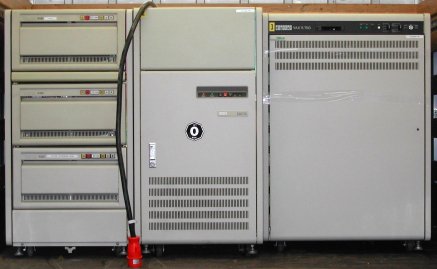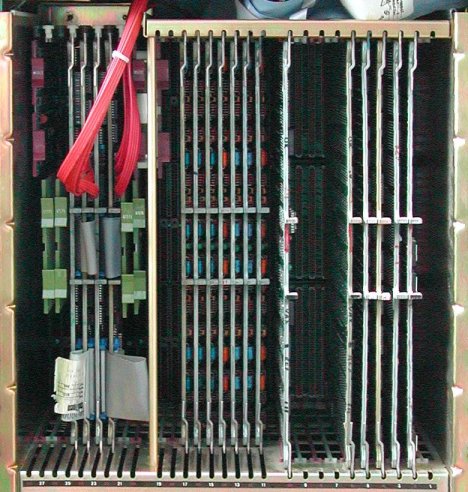
| SYSTEM OVERVIEW | VAX-11/750 |

This page does not describe a PDP-11, but I received this configuration from Kender Thijssen, a company that would otherwise
have scrapped this machine. As my collection is focussed on PDP-11's, I justify this addition to my collection as the machine that
formed the bridge between the PDP-11 and the VAX time line. The first VAX was the VAX-11/780 which is a big machine. The VAX-11/780 had
two decendants, the VAX-11/750 and the VAX-11/730. These two are smaller but are also slower than its big brother.
VAX is an abbreviation for Virtual Address eXtension, and the VAX-11/780 is the basis for all performance comparions between
the many VAXen that would be built. The performance figure of the VAX-11/780 is called "one VUP" (VAX Unit of Performance).
With this definition, the VAX-11/750 is 0.8 VUP, and the VAX-11/730 is 0.6 VUP (the slowest of all VAXen).
The nice thing about these VAX-11/7x0's is that they show their heritage: they can run PDP-11 software in a so-called
compatibility mode, and that is a feature only available in these three models. Actually, the internal hardware consists of
the "VAX stuff" with a module that interfaces to UNIBUS, so all PDP-11 peripherals can be connected to
these VAXen! The picture shows from the right to the left, the VAX-11/750, a HSC70, and a cabinet with three RA81 drives,
just before I unloaded the cabinets from the truck. I wished I had that much space in the house! And believe me, the cabinet
with the three disks is the heaviest (over 200 kilos)! If you click on the picture, a larger picture opens
(787x484 pixels, 62 kb).
This VAX-11/750 has served in two locations. It (she?) was used in a Fokker production line. Fokker was a Dutch company
that developed and built commercial air planes, but went out of business in 1996. The founder, Anthony Fokker was one
of the pioneers in aviation. Later, this VAX-11/750 returned to Kender Thijssen, a company that offered DIGITAL
systems (sale/hire) and consultancy and servicing. That company still exists and used the VAX for test purposes. Through the HSC70
they connected disk and tape (RAxx/TAxx) units to run VAX diagnostic programs during a long time for these devices. This VAX
operated flawlessly for more than 4 years, so I can be called lucky to own such a reliable system!
I made a gentleman's agreement with Kender Thijssen that I will delete all information on the disks, so as soon as I
have some knowledge of (Open)VMS, the Operating System for this machine, I will start up the system to delete everything.
I will have to figure out a way to install VMS (I do have a hobbyist license), but that's for later ...
| Back to top |
I received the following documentation from Kender Thijssen with this system.

| Back to top |
These are the more interesting links I found in my search for information on the VAX-11/7x0 system.
You can find are many links on the Web which deal with running NetBSD on the VAX-11/750.
In my humble opinion you should run a | D | I | G | I | T | A | L | Operating System on a VAX !
| Back to top |

| Back to top |
 |
|
| Back to top |

The VAX–11/750 control panel is on the front of the computer and has of the following indicators and switches.
Indicator Lights
There are seven indicator lights on the control panel. The first three indicate the state of the computer. The remaining four
indicate the state of the remote diagnostic procedures, if that option is available.
| POWER | Glows green when power is supplied to the VAX. |
| RUN | Glows green when the VAX is running. |
| ERROR | When dimly lit, the VAX is running normally! When brightly lit, the VAX has detected an unrecoverable error. If an error occurs, push the white RESET button to reset the VAX. The ERROR light remains dimly lit. If the light is not lit during normal operation, the bulb is probably defective. |
| REMOTE D | Glows green when the keylock switch is in the Remote or the Remote Secure position. |
| RD FAULT | Glows red for 10 seconds when the VAX with a remote diagnostic ROM is turned on. This indicates that a selftest is in progress. When this light glows red for more than 10 seconds, the remote diagnostic ROM has detected an error in the remote diagnostic module. |
| RD TEST | Glows amber when remote diagnostic tests are in progress. |
| RD CARRIER | Glows green when the remote diagnostic center has established a connection with the console subsystem of the VAX. |
| BOOT | Boots the system from the drive selected
by the Boot Device switch. This is the setting for normal system operations. |
| RESTART | (boot) Attempts to restart the system. If the restart fails, boots the system from the drive selected by the Boot Device switch. |
| HALT | Stops the VAX and displays the console-mode prompt (>>>) on the console terminal. |
| RESTART | (halt) Attempts to restart the system. If the restart fails, stops the system and displays the console-mode prompt (>>>) on the console terminal. |
| OFF | Power is supplied to the battery backup unit and to the time-of-year clock, but not to the computer. |
| SECURE | You cannot use the local console terminal in console mode
to control the computer. You can use it in program mode as a user terminal. Pressing Ctrl/P has no effect. A
|D|I|G|I|T|A|L| diagnostics center cannot use the remote console terminal when the switch is set to
SECURE. Pressing the Reset button has no effect because it executes a console mode command. |
| LOCAL | You can use the local console terminal in console mode to control the computer. A |D|I|G|I|T|A|L| diagnostics center cannot use the remote console terminal when the switch is set to LOCAL. |
| REMOTE/SECURE | You cannot use the local console terminal. A
|D|I|G|I|T|A|L| diagnostics center can use the remote console terminal in both console and program mode,
but cannot use it for fault isolation. Pressing the Reset button has no effect because it executes a console mode command. |
| REMOTE | A |D|I|G|I|T|A|L| diagnostics center is in control of the remote console terminal. You cannot use the local console terminal. However, the |D|I|G|I|T|A|L| diagnostics center can enter commands to restore control to the local console terminal. |
| Back to top |